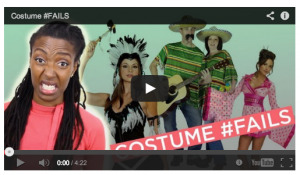
As many Sociology and Feminist blogs are writing, it’s that time of year. The racist, classist, homophobic, sexist tendencies and expressions make me cringe.
This morning, for my Soc 101 class — a large lecture setting of over 150 students — I decided to offer an extra credit project. As discussed previously, students struggle with this large GE style class. I like to offer meaningful, analytical extra credit projects through out the semester.
I use Allen Johnson‘s text called, Forest & the Trees, Sociology as Life, Practice, and Promise and we are about to begin the inequality chapter. So, perfect timing. Feel free to use the assignment (below) and revise it as you wish.
I want to give a shout out to the scholars, blogs and websites that had all the material available. :-) I would love to keep adding to this assignment and publish a bit earlier in the fall for next year. So, I welcome you to post additional links. For example, I don’t have a “working class” resource but we certainly have seen offensive “white trash” parties, costumes, etc.
PS — My own kids are going trick-or-treating as twin witches. I have a 4 year old Pablo and a 3 year old Cecilia. Pablito chose their costumes. We usually do about four houses, and then head back to our own house to hand out candy. Our block is pretty scary for Halloween!
STEP 1 – DO SOME RESEARCH AND LEARNING (RACE / GENDER)
1) Watch the video and read the overviews…
http://www.gender-focus.com/2013/10/24/ffff-franchesca-ramseys-halloween-costume-fails/
http://bitchmagazine.org/post/costume-cultural-appropriation
http://www.sociologyinfocus.com/2012/10/29/were-a-culture-not-a-costume/
2) Learn about what is wrong with “black face” costumes here:
http://racismschool.tumblr.com/post/18422652908/black-face-vs-white-face-whats-the-difference
3) Use this website as a way to analyze others’ costumes. (In encourage you to make adjustments to your own costume if needed!)
http://www.anorak.co.uk/337909/news/this-hampshire-halloween-checklist-is-your-costume-racist.html/
4) Couples costumes?
https://thesocietypages.org/socimages/2013/10/23/heteronormativity-in-halloween-costumes/
5) Sexist costumes – double standard (bacon, yes bacon)
https://thesocietypages.org/socimages/2012/10/24/a-halloween-gender-binary/
6) How things have changed? Are girls dressed up “sexier”?
https://thesocietypages.org/socimages/2013/10/27/halloween-costumes-then-and-now/
7) American Indian costumes – why they are offensive
http://nativeappropriations.com/2011/10/halloween-costume-shopping-a-sampling-of-the-racism-for-sale.html
http://nativeappropriations.com/2011/10/open-letter-to-the-pocahotties-and-indian-warriors-this-halloween.html
8) Dog costumes
https://thesocietypages.org/socimages/2013/10/24/can-we-at-least-agree-that-its-racist-to-dress-your-dog-up-like-a-racial-caricature/
9) How do you politely explain to a friend that their chosen Halloween costume could be racist?
http://www.washingtoncitypaper.com/blogs/sexist/2009/10/28/how-to-inform-a-friend-their-halloween-costume-is-racist/
STEP 2 — OBSERVE YOUR SOCIAL WORLD
Whether you dress up or not, on Thursday check out the costumes people are wearing. Become an embedded Sociologist as you attend parties, while you are at work, go trick-or-treating with your kids, or just walk around outside.
Note what people are wearing, note the racial undertones (or racist costumes), the gender performances of men and women in their costumes, etc. Note how people dress their dogs, kids, etc., on these issues as well.
Write up what you see / hear in detail. Insert photos in your word document if you wish. Do this Friday, so your memory is fresh!! (You can send me your notes if you want to show me your progress.)
Then, reflect explicitly on what you have learned from the above websites and resources. Include the course material from Unit 4 / Forest&Trees Chapter 3. Be sure you are clear about what sources you are using and drawing upon in your discussion. Tie all this together — what you see, what you learned, and your reflections.
No need to do “official” citations but do mention the website, video, or author as you reflect on them.
Aim for 2-3 pages of text. Turn in a paper copy to me in class AND post on “Caring is Sharing Forum” at the top of our course website.
DUE DATE — Wednesday, November 6 in class / uploaded that night.
Earn up to five points!!!
—–
You can follow Dr. Clark-Ibáñez on Twitter at @MCIcsusm

Comments 1
Halloween roundup | Memoirs of a SLACer — October 31, 2013
[…] The Society Pages discuss Halloween class assignments. […]